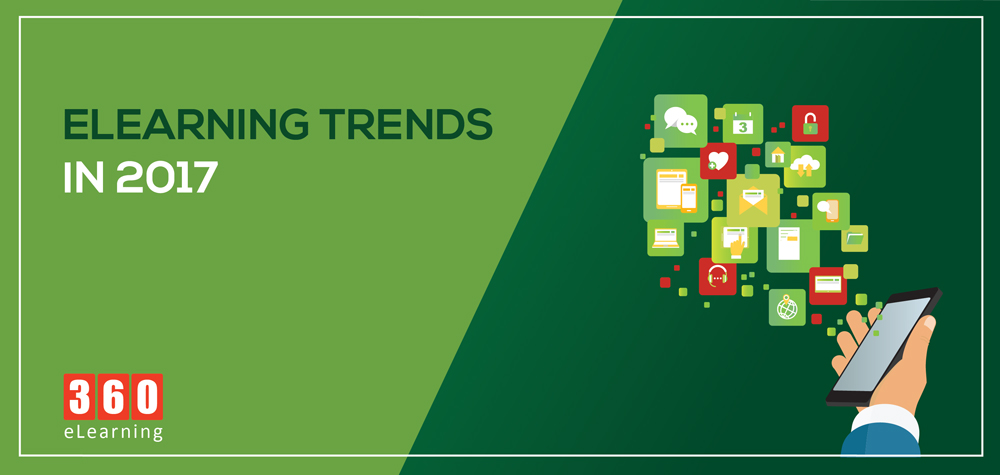In the beginning of each new year, thought leaders and industry experts usually predict which trends will take off in the next 11-12 months. We like to keep on top of emerging and growing trends in the market as well, but wanted to share some hard-hitting statistics to back up our claims. Below are our top eLearning trends in 2017 to know for (plus some general stats about the LMS market).
1. Contextual Learning
Learning and Development teams will use modern design thinking to modernize typically boring eLearning courses like Onboarding. The Learning and Development world is setting up to this idea that we need to move beyond just resource-based approaches for eLearning. We need to think about multi-pronged approaches that fit in different consumption windows and patterns, as well as delivering against needs.
2. Two-Way Communication In eLearning
It’s now easier than ever to capture feedback from learners within content. You can now open up for users’ input and ideas on what they’d like to see or what they need help with.
For example, use your eLearning authoring tool to gauge needs and wants upfront: send out some polls, questionnaires, or content to seed thinking and then capture opinions. Then shape your strategy around it.
3. Performance Support vs. Learning Experiences
Expect to see Learning and Development teams considering on-the-job support needs for each project in 2017. You will see more learners opt for Google’s and YouTube’s quick look-up materials as a first point of call, and especially when they have an urgent need.
This leaves room for true learning content, and by that we mean learning experiences, not just content. The lengthy “everything goes in” approach will make way for performance-enhancing content that builds competence, reflection, exploration, and personal growth through challenging and provocative content.
4. Social eLearning
In most organizations, social learning and informal learning happens around eLearning experiences.
There is great power in social polling, where learners can give their opinion or rate something, like a video, and then see what everyone else thinks. This enables learners to explore the gray spaces rather than the strict black and white or right and wrong spaces eLearning has often limited itself to in the past.
5. Video eLearning
Video content use is increasing. By 2019, video will be responsible for 80 percent of internet traffic around the world. Expect users to share almost one million minutes of video content every second by 2019. Thus, it’s no surprise Facebook’s Mark Zuckerberg projects that video will be the most shared content on Facebook within in the next five years.
6. Micro eLearning
Microlearning is more than a fad. It provides a structure to deliver learning content in a way that that fits with what we know about how people learn – short, focused, regular challenges that stretch and, perhaps, reward us. It’s huge in the United States and gradually gaining worldwide popularity. You’ve seen it in learning apps, such as Duolingo, and it’s a model that grows with the learner.
In 2017 you’ll see less discussion on “resources not courses”, and more focus on approaches that use microlearning to personalize and structure content in digestible sizes.
7. Content Cu-ration
Cu-ration of content will be on the rise in 2017. Expect to see more carefully selected, user-focused eLearning content, including blogs, forum threads, guides, videos, and articles.
This will help learning teams create a modern and holistic set of learning content delivered via designed content or multiple resources that don’t need to be made from scratch.
Christopher Pappas has a good guide on curation for learning, as does Anders Pink with their checklist for Learning and Development professionals.
8. Better Use of Data
Using data in an intelligent way can help shape your learners’ experience. For example, using Elucidat you can view analytics to learn how to quickly see where you need to improve your eLearning content.
Data offers a smart way to personalize learning content. For example, show learners how their thinking compares with their peers’ by presenting live social-polling results. Personalize content and serve up certain pages of content specifically for someone’s needs because they answered questions A, C, and F in a certain way.
9. Mobile Learning
Learning content is accessed via mobile devices by about 70% of learners. That’s why we predict that mobile learning will continue to rise in popularity in 2017. Oftentimes, learners are switching from one device to another depending on their location or needs.
Let’s hope everyone gets their content genuinely responsive, as this has been slow in parts!
10: Gamification
Gamification is no longer a buzz word in the LMS and training industry. This is a feature many prospective LMS clients are looking for good reason.
This doesn’t always mean learning is a literal game, but might have gaming elements such as a leaderboard or badges that are awarded upon completion.
11. Go Beyond “eLearning”
The debate about what to call “eLearning” is expected to continue in 2017. Whether you call it “online learning” or “digital performance enablement”, it’s important to realize that what’s needed is a mindset shift to modernize learning design.
We need to think of terms like “eLearning” as being much, much broader than they were five or more years ago. Don’t get obsessed with a “new way” or new name that will inevitably change in a few years anyway.
LMS Market
If you’ve been keeping up with the LMS market at all then we’re sure you’ve seen the large growth that’s been happening year over year. Case and point, there are now over 700 LMS providers (or even 1,000 depending on who you’re asking) in the market.



[…] are the days when learners would only use desktop computers to access a fixed eLearning course but trends […]
[…] devices and the fact that it is apt to the current generation has added a fuel to this popular eLearning trends. Despite its heavy acceptance, mLearning is facing some real time challenges to prove its […]